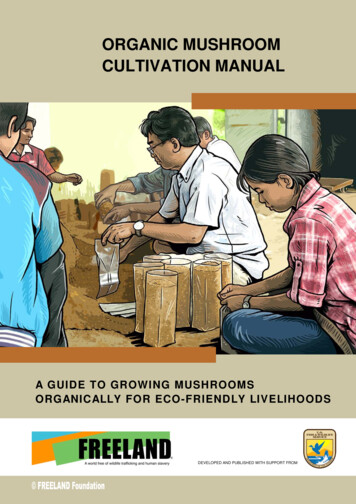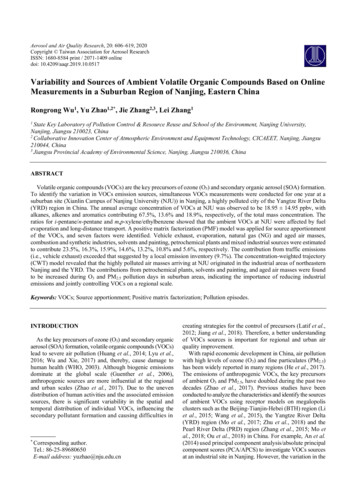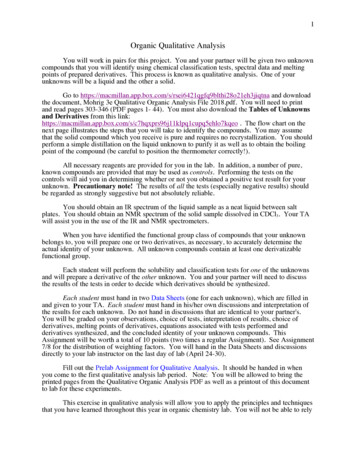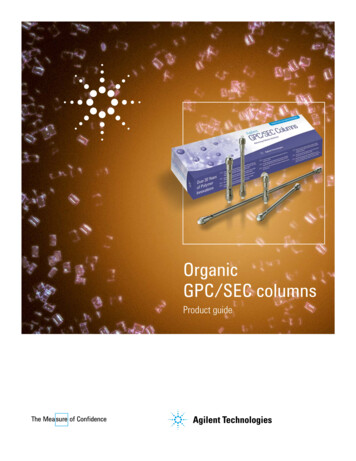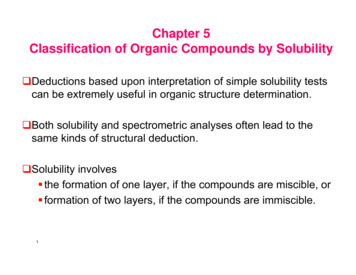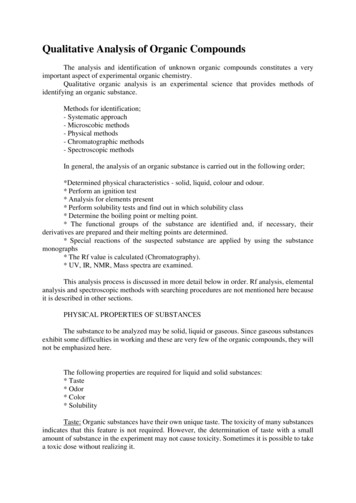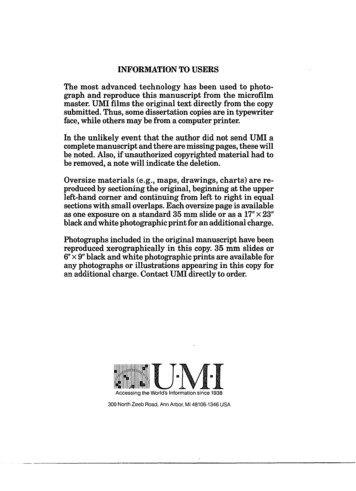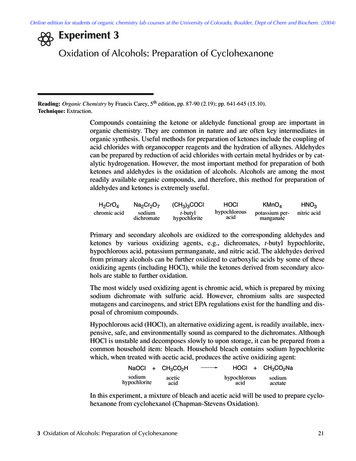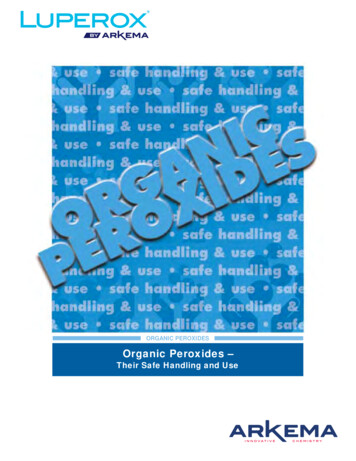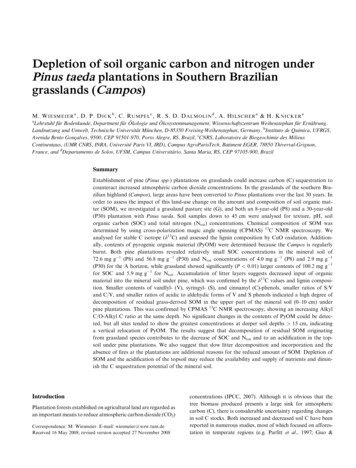
Transcription
European Journal ofSoil ScienceEuropean Journal of Soil Science, June 2009, 60, 347–359doi: 10.1111/j.1365-2389.2009.01119.xDepletion of soil organic carbon and nitrogen underPinus taeda plantations in Southern Braziliangrasslands (Campos)M. W IESMEIER a , D. P. D ICK b , C. R UMPEL c , R. S. D. D ALMOLIN d , A. H ILSCHER a & H. K NICKER aaLehrstuhl für Bodenkunde, Department für Ökologie und Ökosystemmanagement, Wissenschaftszentrum Weihenstephan für Ernährung,Landnutzung und Umwelt, Technische Universität München, D-85350 Freising-Weihenstephan, Germany, bInstituto de Quimica, UFRGS,Avenida Bento Goncxalves, 9500, CEP 91501-970, Porto Alegre, RS, Brazil, cCNRS, Laboratoire de Biogeochimie des MilieuxContinentaux, (UMR CNRS, INRA, Université Paris VI, IRD), Campus AgroParisTech, Batiment EGER, 78850 Thiverval-Grignon,France, and dDepartamento de Solos, UFSM, Campus Universitário, Santa Maria, RS, CEP 97105-900, BrazilSummaryEstablishment of pine (Pinus spp.) plantations on grasslands could increase carbon (C) sequestration tocounteract increased atmospheric carbon dioxide concentrations. In the grasslands of the southern Brazilian highland (Campos), large areas have been converted to Pinus plantations over the last 30 years. Inorder to assess the impact of this land-use change on the amount and composition of soil organic matter (SOM), we investigated a grassland pasture site (G), and both an 8-year-old (P8) and a 30-year-old(P30) plantation with Pinus taeda. Soil samples down to 45 cm were analysed for texture, pH, soilorganic carbon (SOC) and total nitrogen (Ntot) concentrations. Chemical composition of SOM wasdetermined by using cross-polarization magic angle spinning (CPMAS) 13C NMR spectroscopy. Weanalysed for stable C isotope (d13C) and assessed the lignin composition by CuO oxidation. Additionally, contents of pyrogenic organic material (PyOM) were determined because the Campos is regularlyburnt. Both pine plantations revealed relatively small SOC concentrations in the mineral soil of72.6 mg g 1 (P8) and 56.8 mg g 1 (P30) and Ntot concentrations of 4.0 mg g 1 (P8) and 2.9 mg g 1(P30) for the A horizon, while grassland showed significantly (P 0.01) larger contents of 100.2 mg g 1for SOC and 5.9 mg g 1 for Ntot. Accumulation of litter layers suggests decreased input of organicmaterial into the mineral soil under pine, which was confirmed by the d13C values and lignin composition. Smaller contents of vanillyl- (V), syringyl- (S), and cinnamyl (C)-phenols, smaller ratios of S/Vand C/V, and smaller ratios of acidic to aldehydic forms of V and S phenols indicated a high degree ofdecomposition of residual grass-derived SOM in the upper part of the mineral soil (0–10 cm) underpine plantations. This was confirmed by CPMAS 13C NMR spectroscopy, showing an increasing AlkylC/O-Alkyl C ratio at the same depth. No significant changes in the contents of PyOM could be detected, but all sites tended to show the greatest concentrations at deeper soil depths 15 cm, indicatinga vertical relocation of PyOM. The results suggest that decomposition of residual SOM originatingfrom grassland species contributes to the decrease of SOC and Ntot and to an acidification in the topsoil under pine plantations. We also suggest that slow litter decomposition and incorporation and theabsence of fires at the plantations are additional reasons for the reduced amount of SOM. Depletion ofSOM and the acidification of the topsoil may reduce the availability and supply of nutrients and diminish the C sequestration potential of the mineral soil.IntroductionPlantation forests established on agricultural land are regarded asan important means to reduce atmospheric carbon dioxide (CO2)Correspondence: M. Wiesmeier. E-mail: wiesmeier@wzw.tum.deReceived 16 May 2008; revised version accepted 27 November 2008# 2009 The AuthorsJournal compilation # 2009 British Society of Soil Scienceconcentrations (IPCC, 2007). Although it is obvious that thetree biomass produced presents a large sink for atmosphericcarbon (C), there is considerable uncertainty regarding changesin soil C stocks. Both increased and decreased soil C have beenreported in numerous studies, most of which focused on afforestation in temperate regions (e.g. Parfitt et al., 1997; Guo &347
348 M. Wiesmeier et al.Gifford, 2002; Ross et al., 2002). However, when consideringdifferent tree species, it seems that under hardwoods soil C generally increases, whereas under plantations with softwoods, particularly Pinus species, soil organic C (SOC) is lost (Guo &Gifford, 2002; Paul et al., 2002). Several mechanisms have beendiscussed to account for this decline, but few studies provideobjective evidence for the processes assumed to occur. In tropical and subtropical regions, where large parts of natural savannas and grasslands were converted to plantations with Pinusspp. during the previous 30 years (Le Maitre, 1998), data on theimpact of these afforestations on SOM properties are scarce(Lilienfein et al., 2000; Zinn et al., 2002). The grasslands in thesouth Brazilian highlands (Figure 1), commonly referred to asCampos, belong to a region where large areas of grassland underpasture were afforested, mainly with Pinus spp. (Goldammer,1993). In contrast to the adjacent Pampa biome, the Campos isa mosaic of natural grasslands and different forest types andoccupies approximately 13.7 million ha (Nabinger et al., 2000).As Overbeck et al. (2007) recently pointed out, large parts of theCampos have been transformed to pine plantations because economic returns are greater than for cattle production. Therefore,the Campos area is decreasing at a rate of 135 000 ha per year(Carvalho, 2006) and has lost approximately 25% of its area inthe last 30 years as a consequence of conversion to cash cropsand pine plantations (Nabinger et al., 2000; Overbeck et al.,2007). However, no studies concerning the impacts of these landuse changes on soil properties are available.As soil organic matter (SOM) has a particular importance forsoil fertility in tropical and subtropical soils, any decline wouldresult in a significant degradation of these soils. Recent studies ofthe Campo area clearly indicated that such a decline of SOCand total nitrogen (Ntot) can be induced by stopping prescribed burning at the end of the winter (Knicker et al., 2008a).Other studies demonstrate that burning is an important process to maintain SOC contents in grasslands (Lal, 2004; Chenet al., 2005; Dai et al., 2006). However, no studies are availablethat report to what extent the decline of SOM is reduced byplantation of pines after burning has been stopped. Therefore,we investigated the effect of afforestation with Pinus taeda onformer grassland from the Campos in Rio Grande do Sul,Brazil. Both 8-year-old (P8) and 30-year-old (P30) pine plantations were sampled and the chemical composition, analysed bysolid-state 13C NMR and determination of stable isotope ratios(d13C) and lignin oxidation products, was compared with thatof native grassland soil (G). The content of pyrogenic organicmatter (PyOM) was measured by chemical oxidation with acidpotassium dichromate. The hypotheses were: that (i) there isa change in the concentration of SOC and composition of SOMas a result of afforestation and (ii) that there are direct effectscaused by planting pines and indirect effects induced by theabsence of vegetation fires in pine plantations. We investigatedthe mechanisms responsible for the possible changes.Materials and methodsStudy area and samplingThe research was conducted in the highlands (Planalto – Camposde Cima da serra) in the northeast of Rio Grande do Sul,southern Brazil (28 35 – 39 S, 49 51 – 57 W) at an averagealtitude of 1280 m above sea level. Climate is characterized asa transition between subtropical and temperate conditions,with a mean annual temperature of 14.5 C, large precipitation(annual values of 1800–2000 mm), a short dry period of lessthan 2 months in the summer and up to 15 days with frostduring winter (Nimer, 1979).Figure 1 Map of South America showing the location of the Campos (adapted after Hueck, 1966) and the study area.# 2009 The AuthorsJournal compilation # 2009 British Society of Soil Science, European Journal of Soil Science, 60, 347–359
Depletion of SOM under Pinus taeda plantations 349The soils are classified as Leptosols with Ah thickness of25 cm and as Umbrisols with Ah of 30 cm (IUSS WorkingGroup WRB, 2006), derived from acid volcanic rocks. Thediverse vegetation (3000–4000 phanerophytic species) of thegrassland in the south Brazilian highland is composed of tropical, continental and temperate species belonging to the families Poaceae, Cyperaceae, Asteraceae, Apiaceae, Fabaceae andEriocaulaceae, with a large proportion of C4-grasses (Behling,1997). For the grassland studied, fire was used as a management tool approximately every 2 years after the winter seasonto remove grass and shrub biomass, to stimulate the regrowthafter the winter and to supply nutrients. Further informationconcerning the Campos region is presented by Overbeck et al.(2007).Soil material was taken from the A horizon of a grasslandpasture (site G) and two former grassland sites, that were converted into Pinus taeda plantations 8 (site P8) and 30 years (siteP30) before sampling. Samples were split into depth increments of 0–5 cm, 5–10 cm, 10–15 cm, 15–25 (30) cm and from25 (30) to 45 cm (C horizon). At each site, four profiles separated by a distance of 10–30 m were sampled. Additionally,grass material (Gr) from site G, and also pine needle litter (N)and material from the Oe and Oa horizon of site P8 were collected. No fires occurred after afforestation and the grasslandarea was last burnt 9 months before sampling. At all sites, theslopes were 3%. For determination of the bulk density(BD), undisturbed soil samples were taken from two locationswith 6 cm diameter metal cores. Before grinding, the sampleswere air-dried and passed through a 2 mm sieve.Determination of soil propertiesFor the analyses of soil texture, two samples ( 2 mm) fromeach site were oxidized with H2O2 to remove organic material.The remaining material was dispersed with Na4P2O7 andshaken for at least 16 hours, followed by wet sieving to isolatesand fractions (2000–63 mm). To determine silt and clay fractions, approximately 3 g of the 63 mm fraction was suspended in deionized water with Na4P2O7 and followed byultrasonication for 3 minutes with 75 J ml 1. Afterwards, thedistribution of silt (63–2 mm) and clay ( 2 mm) fractions wasobtained by measuring the X-ray absorption of the soil-watersuspension during sedimentation of the soil particles witha Micrometrics Sedigraph 5100 (Norcross, GA, USA).The bulk density of the A-horizon was quantified for twosamples from each site with the mass of the oven-dry soil(105 C) divided by the core volume (Hartge & Horn, 1989). SoilpH values for four samples from each site were measured in0.01 M CaCl2 at a soil/solution ration of 1:2.5 at room temperature. SOC and Ntot in four samples from each site weredetermined in duplicates by dry combustion on a CHN autoanalyser (CHN NA 1500, Carlo Erba, Rodano, Italy). As allsamples were free of carbonate, the measured C concentrations represent the SOC concentrations.Analysis of the d 13C isotope ratiosThe stable C isotope ratios were measured for four samples fromeach site by a CHN auto analyser coupled to an isotope ratiomass spectrometer (VG Sira 10, VG Isotech, Middlewich, UK).The laboratory reference was calibrated against the international standard Vienna Pee Dee Belemnite (VPDB). Carbon isotope ratios were expressed in the delta notation for d13C withunits of per thousand (&), which is the difference in the13C/12C ratio between a sample and the VPDB standard:d13 C ¼ð13 C 12 CÞsampleð13 C 12 CÞVPDB! 1 1000:ð1ÞLignin quantitative analysisLignin contents were analysed for two samples from each siteusing a modified method of the alkaline CuO oxidation method(Hedges & Ertel, 1982). Approximately 200 mg or 50 mg of soiland plant material, respectively, were placed in Teflon vesselsand oxidized with 15 ml 2 M NaOH, 250 mg CuO, 50 mgFe(NH4)2(SO4)2 6H2O and 50 mg glucose in a pressure bomb(Groteklaes, Jülich, Germany) at 172 C for 2 hours undera N2 atmosphere. Ethylvanillin was added after oxidation asan internal standard in order to control the recovery of ligninmonomers, which is usually in the range of 60–75% (Dignacet al., 2005). The solution was quantitatively transferred toglass beakers, adjusted to pH 1.8–2.2, and the generatedlignin-derived phenols were cleaned by C18 columns (International Sorbent Technology, Hengoed, UK). The eluate wasdried under N2 and silylated for gas chromatographic analysis.Determination of CuO oxidation products was carried out witha HP GC 6890 gas chromatograph, equipped with a SGE BPX5 column and a flame ionization detector (FID) in the splitmode (1:10). The oven temperature was programmed from100 C (held for 2 minutes), to 172 C with a linear increase of8 C min 1, and to 184 C at a rate of 4 C min 1. The final temperature of 300 C was reached at a rate of 10 C min 1.CuO oxidation yields a suite of phenolic oxidation productscomposed of vanillyl (V), syringyl (S) and cinnamyl (C) unitswith aldehydic, ketonic and acidic side chains. V-type phenolsare derived from coniferyl alcohol that is generated from gymnosperm lignin (Kögel-Knabner, 2002). They consist of concentrations of vanillin, acetovanillone and vanillic acid. S-typephenols are the sum of syringaldehyde, acetosyringone andsyringic acid and originate from sinapyl alcohol units. In angiosperms, the lignin is built up from equal amounts of coniferyland sinapyl alcohol (Johansson et al., 1986). C-type compounds consist of ferulic and p-coumaric acid components.Solid-state CPMAS13C NMR spectroscopyPrior to the NMR spectroscopic analysis, two samples fromeach site were enriched in SOM by depleting the paramagnetic# 2009 The AuthorsJourna
sand fractions (2000–63 mm). To determine silt and clay frac-tions, approximately 3 g of the 63 mm fraction was sus-pended in deionized water with Na 4P 2O 7 and followed by ultrasonication for 3 minutes with 75 J ml 1. Afterwards, the distribution of silt (63–2 mm) and clay ( 2 mm) fractions was
